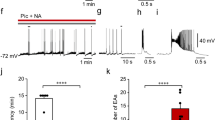Abstract
CHRONIC administration of either tricyclic antidepressant drugs or monoamine oxidase inhibitors, which are effective in the treatment of endogenous depression, has been shown to decrease the sensitivity of nor adrenaline (NA)-stimulated adenylate cyclase1–5 and to decrease the apparent density of β-adrenergic receptor binding sites in rat brain6–10. This alteration in receptor mechanisms by antidepressant drugs seems to be selective, as neither α-adrenergic nor serotonergic receptor binding in rat cortex is altered by the tricyclic drug desipramine7. It is therefore of interest to know whether other forms of antidepressant intervention alter receptor mechanisms in the brain and if so, whether they display a time course and selectivity similar to that of antidepressant drugs. Here, we have investigated the effects of a single and of multiple electroconvulsive shocks (ECS) on rat brain monoaminergic receptor binding sites and report that the density of β-adrenergic receptors is decreased.
This is a preview of subscription content, access via your institution
Access options
Subscribe to this journal
Receive 51 print issues and online access
$199.00 per year
only $3.90 per issue
Buy this article
- Purchase on Springer Link
- Instant access to full article PDF
Prices may be subject to local taxes which are calculated during checkout
Similar content being viewed by others
References
Vetulani, J., Stawarz, R. J. & Sulser, F. J. Neurochem. 27, 661–666 (1976).
Vetulani, J., Stawarz, R. J., Dingell, S. V. & Sulser, F. Naunyn-Schmiedebergs Archs Pharmak. 293, 109–114 (1976).
Vetulani, J. & Sulser, F. Nature 257, 495–496 (1975).
Frazer, A., Pandey, G., Mendels, J., Neeley, S., Kane, M. & Hess, M. E. Neuropharmacology 13, 1131–1140 (1974).
Schultz, J. Nature 261, 417–418 (1976).
Banerjee, S. P., Kung, L. S., Riggi, S. J. & Chanda, S. K. Nature 268, 455–456 (1977).
Bergstrom, D. A. & Kellar, K. J. J. Pharmac. exp. Ther. (in the press).
Sellinger, M., Sarai, K., Frazer, A., Mendels, J. & Hess, M. E. Fedn Proc. 37, 309 (1978).
Wolfe, B. B., Harden, T. K., Sporn, J. R. & Molinoff, P. B. J. Pharmac. exp. Ther. 207, 446–457 (1978).
Campbell, I. C., Gallagher, D. W., Murphy, D. L. & Tallman, J. Soc. Neurosci. Abstr. 4, 269 (1978).
Alexander, R. W., Davis, J. N., Lefkowitz, R. J. Nature 258, 437–439 (1975).
Bylund, D. B. & Snyder, S. H. Molec. Pharmac. 12, 568–580 (1976).
Greenberg, D. A. & Snyder, S. H. Life Sci. 20, 927–932 (1977).
Greenberg, D. A. & Snyder, S. H. Molec. Pharmac. 14, 38–49 (1978).
Williams, L. T., Mullikin, D. & Lefkowitz, R. J. J. biol. Chem. 251, 6915–6923 (1976).
U'Prichard, D. C., Greenberg, D. A. & Snyder, S. H. Molec. Pharmac. 13, 454–473 (1977).
Bennett, J. P. Jr & Snyder, S. H. Molec. Pharmac. 12, 373–389 (1976).
Burt, D. R., Creese, I. & Snyder, S. H. Molec. Pharmac. 12, 800–812 (1976).
Fields, J. Z., Reisine, T. D. & Yamamura, H. I. Brain Res. 136, 578–584 (1977).
Scatchard, G. Ann. N.Y. Acad. Sci. 51, 660–672 (1949).
Musacchio, J. M., Julou, L., Kety, S. S. & Glowinski, J. Proc. natn. Acad. Sci. U.S.A. 63, 1117–1119 (1969).
Kety, S. S., Javoy, F., Thierry, A. M., Julou, L. & Glowinski, J. Proc. natn. Acad. Sci. U.S.A. 58, 1249–1254 (1967).
Ladisich, W., Steinhauff, N. & Matussek, N. Psychopharmacologia 15, 296–304 (1969).
Hendley, E. D. & Welch, B. L. Life Sci. 16, 45–54 (1975).
Modigh, K. Psychopharmacologia 49, 179–185 (1976).
Deguchi, T. & Axelrod, J. Proc. natn. Acad. Sci. U.S.A. 70, 2411–2414 (1973).
Kebabian, J. W., Katz, M., Romero, J. A. & Axelrod, J. Proc. natn. Acad. Sci. U.S.A. 72, 3735–3739 (1975).
Mickey, J., Tate, R. & Lefkowitz, R. J. J. biol. Chem. 250, 5727–5729 (1975).
Mukherjee, C., Caron, M. G. & Lefkowitz, R. J. Proc. natn. Acad. Sci. U.S.A. 72, 1945–1949 (1975).
Makman, M. H. Proc. natn. Acad. Sci. U.S.A. 68, 2127–2130 (1971).
Author information
Authors and Affiliations
Rights and permissions
About this article
Cite this article
BERGSTROM, D., KELLAR, K. Effect of electroconvulsive shock on monoaminergic receptor binding sites in rat brain. Nature 278, 464–466 (1979). https://doi.org/10.1038/278464a0
Received:
Accepted:
Issue Date:
DOI: https://doi.org/10.1038/278464a0
This article is cited by
-
Electroconvulsive Therapy Alters Dopamine Signaling in the Striatum of Non-human Primates
Neuropsychopharmacology (2011)
-
Does Ca2+ channel blockade modulate the antidepressant-induced changes in mechanisms of adrenergic transduction?
Journal of Neural Transmission (1997)
-
Transcranial magnetic stimulation downregulates ?-adrenoreceptors in rat cortex
Journal of Neural Transmission (1996)
-
Mapping of Cerebral Blood Flow Changes during Audiogenic Seizures in Wistar Rats: Effect of Kindling
Journal of Cerebral Blood Flow & Metabolism (1995)
-
Electroconvulsive shock increases dopamine D1 and D2 receptor mRNA in the nucleus accumbens of the rat
Psychopharmacology (1995)
Comments
By submitting a comment you agree to abide by our Terms and Community Guidelines. If you find something abusive or that does not comply with our terms or guidelines please flag it as inappropriate.



